The River Clyde is one of Scotland’s longest rivers and one of its most important bodies of water. From its source in the Lowther Hills, it meanders its way through South Lanarkshire, then flows through Glasgow City Centre. At the “Tale of the Bank”, it widens to become the Firth of Clyde and drifts into the Atlantic Ocean.
In this blog, we’ll discover the story behind the Firth of Clyde and its important role in Scotland’s life.
How long is the River Clyde?
The short answer is that the length of the River is about 106 miles (170 km).
Industrial towns on the River Clyde include Port Glasgow, Dumbarton, and Greenock. Further upstream, New Lanark’s historic cotton mills were powered by the cascading waters of the Falls of Clyde. This model community is of such importance it has become a UNESCO World Heritage Site.
A little downstream, the River flows past Hamilton, famous for its racecourse, then Blantyre, the birthplace of explorer David Livingstone.
River Clyde in Glasgow
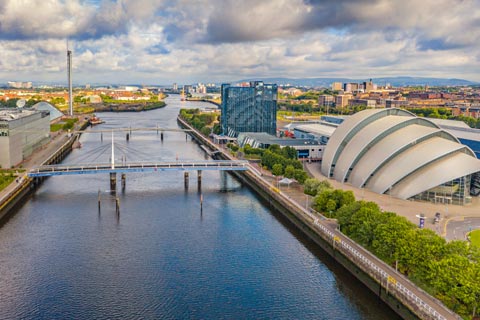
The River Clyde has played a significant role in the history and development of Glasgow. In the past, it was a vital waterway for trade and transportation, allowing ships to reach the city’s busy port.
Today, the River continues to be an important part of Glasgow’s landscape and culture. The Clyde Waterfront area has undergone massive change, transforming former industrial sites into vibrant residential, commercial, and leisure spaces.
The riverside is home to BBC Scotland, the Glasgow Science Centre, the OVO Hydro Arena and the Scottish Event Campus.
Clydebuilt
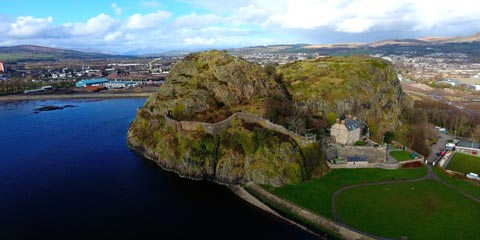
The River continues to Clydebank, where John Brown shipbuilders constructed the “Queen Mary”, “Queen Elizabeth”, and “QE2”. The yard also built the Former Royal Yacht Britannia. This once floating palace is now a popular visitor attraction permanently berthed in Leith, outside Edinburgh.
The importance of shipbuilding on the River Clyde was so great that around a fifth of all the ships launched in the World
Dumbarton Castle guards the lower reaches of the River. People say Merlin visited this historic castle, which also has links to Mary Queen of Scots and William Wallace.
What is a firth in Scotland
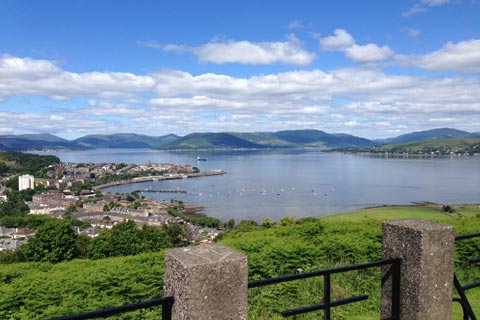
What is a firth? Well, a firth is a narrow sea inlet, the estuary of a river.
The Firth of Clyde is on Scotland’s west coast and flows into the North Atlantic Ocean. It covers an area of over 1500 square miles.
Other firths in Scotland include the Firth of Forth, famous for the three magnificent bridges spanning the River. Further north, the Moray Firth is Scotland’s largest and has a coastline of around 500 miles. It’s home to a colony of bottlenose dolphins, and there are occasional sightings of Minke Whales too.
The Pentland Firth, between mainland Scotland and the Orkney Islands, is known for its strong currents and dangerous tides.
Firth of Clyde Islands
The Firth of Clyde contains around 40 islands and skerries, but only six are inhabited.
Smaller islands include Ailsa Craig, an important bird sanctuary and the Holy Island, which as the name suggests, has a long history as a sacred site. It hosts the Centre for World Peace and Health, a venue for short retreats and study.
The big three Clyde islands are known as ABC - Arran, Bute and Cumbrae (Great and Little - to be precise). All are linked to the mainland by frequent ferry services.
Arran
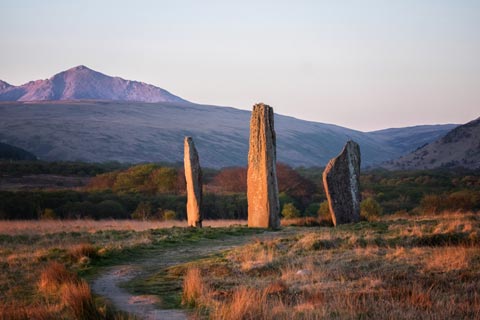
The Isle of Arran is known as “Scotland in Miniature”, as it straddles the Highland Boundary Fault. The island’s south offers gentle scenery, whereas the northern half is home to rugged mountains and solitary glens.
There is much to see and do in Arran, from Brodick Castle and its beautiful gardens to the Iron Age standing stones of Machrie Moor. Make the ascent up Goat Fell, the tallest peak on Arran, to enjoy magnificent landscapes and sea views, then enjoy a glass of amber nectar from the island’s very own whisky distillery.
Keep an eye out for the wildlife too - the “Big Five” call Arran their home, namely golden eagles, otters, red deer, red squirrels and seals. If you’re considering exploring Arran, we have a tour that could be just what you’re looking for. Click here to find out more.
Bute
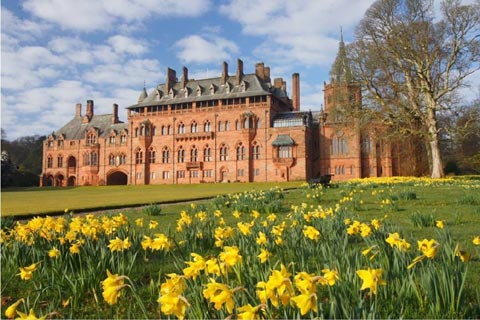
Moving on to Bute, dubbed the “Best Place to Live In Scotland” by The Times back in 2022, the island is rightly famous for its gentle landscapes, sandy beaches and sheltered coves.
The main town on the Isle of Bute is Rothesay, which overlooks a sweeping bay and has strong links to the Victorian era. In the town, visitors will find the Grade A-listed Rothesay Pavillion (currently being upgraded in a multi £million project) and Rothesay Castle, built by the Stewarts to a rare circular design.
Mount Stuart is another of the island’s many treasures, an elaborate Victorian Gothic mansion built by the 3rd Marquess of Bute. Surrounded by 300 acres of grounds, the design of this remarkable house was inspired by art, history, mythology and astrology.
Cumbrae
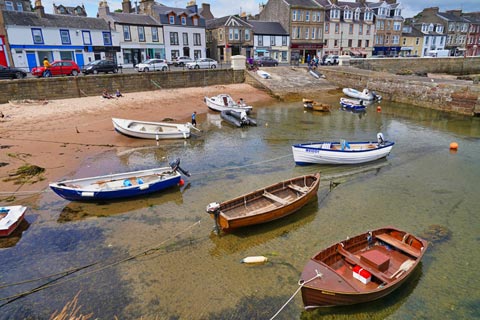
The Isle of Cumbrae refers to Great Cumbrae, which comes in at just 4 miles long and 2 miles wide (remember this, it’s an important fact, and we’ll return to it shortly).
Millport is where all the action happens, including being the location of the smallest cathedral in the UK, based on a design by William Butterfield.
The size of Great Cumbrae makes it perfect for a gentle cycle. The 10-mile loop around the island will provide fantastic coastal views and ensure you see all Cumbrae offers.
And Little Cumbrae? This island is privately owned, although it can be seen from Millport.
As well as the islands, the Firth of Clyde is also the location of several different seaside towns, including Dunoon, Largs and Troon – fabulous for day trips and all within easy access to Glasgow.
Firth of Clyde wildlife
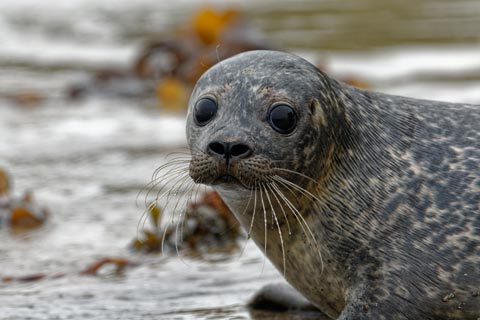
We’ve already alluded to the wildlife you must watch out for in Arran, but the whole area offers a wide range of animals and sea creatures to satisfy any animal lover!
There are too many to list them all here but keep an eye out for dolphins (both the smaller Common Dolphin and the bigger Bottlenose Dolphin have been spotted) and whales.
In the sky, birds including the more uncommonly seen species such as Barn Owls, Tree Sparrows and Swallows. Heading further upstream dippers, ravens and kingfishers can often be seen.
“Doon the watter”
In the 19th and 20th Centuries, when Glasgow was a major industrial centre, the workers in shipbuilding and engineering would escape the smoke and grime by taking a steamer, “Doon the Watter”.
Pleasure steamers would sail from the Broomielaw, in the centre of Glasgow, to holiday resorts like Dunoon, Rothesay and Millport. This trade continued up to the 1950s and 60s when the advent of package holidays overseas became popular.
In its heyday, several steamship lines competed for business by offering faster and more luxurious sailings. The romance of sailing on the Firth of Clyde was immortalised in a popular song by Kenneth McKellar called the “Song of the Clyde”.
PS Waverley
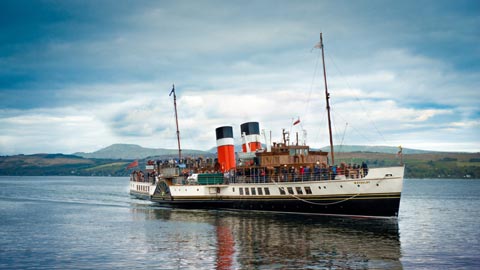
By the 1970s, the change to overseas holidays saw a dramatic downturn in the River Clyde boat trips and many of the older steamships were withdrawn from service and scrapped. In 1973 the PS Waverley was withdrawn from service. She was built as recently as 1947 after her predecessor was sunk in 1940 at Dunkirk.
Rather than see the PS Waverley go to the scrappers, a campaign was launched by the Paddle Steamer Preservation Society to rescue her as a working museum. She was sold into preservation for £1 and thus started a new career.
Today, PS Waverley offers a programme of day excursions from Glasgow during the summer months. As the World’s last sea-going paddle steamer, she also ventures as far afield as the Thames, Solent and Bristol Channel to offer sailings for steam enthusiasts.
Firth of Clyde Tours from Scottish Tours
Yet if reading all about these Scottish waters has piqued your interest, we have a tour called “A Classic Steam Break”, which, as the name suggests, heavily features many water-based activities.
You’ll take a trip to the Falkirk Wheel, board a canal boat and even the PS Waverley – the last paddle steamer to sail the seas – which will take you along the Clyde Estuary. The tour then ends with a final cruise on Loch Katrine. It truly is a tour not to be forgotten!
Click here to see all our Scotland Tours. Book today.

